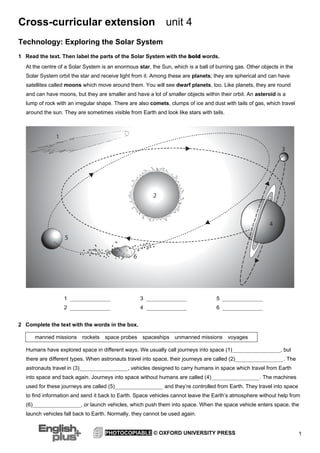More Related Content
Similar to Technology the solar system
Similar to Technology the solar system (20)
More from Mingo Peiro (20)
Technology the solar system
- 1. Cross-curricular extension
unit 4
Technology: Exploring the Solar System
1 Read the text. Then label the parts of the Solar System with the bold words.
At the centre of a Solar System is an enormous star, the Sun, which is a ball of burning gas. Other objects in the
Solar System orbit the star and receive light from it. Among these are planets; they are spherical and can have
satellites called moons which move around them. You will see dwarf planets, too. Like planets, they are round
and can have moons, but they are smaller and have a lot of smaller objects within their orbit. An asteroid is a
lump of rock with an irregular shape. There are also comets, clumps of ice and dust with tails of gas, which travel
around the sun. They are sometimes visible from Earth and look like stars with tails.
1 _______________
3 _______________
5 _______________
2 _______________
4 _______________
6 _______________
2 Complete the text with the words in the box.
manned missions
rockets
space probes spaceships unmanned missions voyages
Humans have explored space in different ways. We usually call journeys into space (1)__________________, but
there are different types. When astronauts travel into space, their journeys are called (2)__________________. The
astronauts travel in (3)__________________, vehicles designed to carry humans in space which travel from Earth
into space and back again. Journeys into space without humans are called (4)__________________. The machines
used for these journeys are called (5)__________________ and they’re controlled from Earth. They travel into space
to find information and send it back to Earth. Space vehicles cannot leave the Earth’s atmosphere without help from
(6)__________________, or launch vehicles, which push them into space. When the space vehicle enters space, the
launch vehicles fall back to Earth. Normally, they cannot be used again.
PHOTOCOPIABLE © OXFORD UNIVERSITY PRESS
1
- 2. 3 Read the text. Then match 1–3 with a–c.
1 Venus
a a dwarf planet
2 Neptune
b a rocky planet
3 Pluto
c a gas giant
4 What do the numbers from the text mean? Match
them with the explanations a–e.
1 900
4 108
2 4.6 billion
5 1977
3 12 billion
a the year that Voyager 1 began its journey into space
b the distance in kilometres travelled by space
probe Voyager 1 so far
c the distance in kilometres that the first space
voyage travelled
d the number of minutes spent in space during the
first manned mission
e the number of years ago that the Solar System
started forming, approximately
5 Read the text again. Then write True or False for
sentences 1–6. Correct the false sentences.
1 The Sun and planets were formed by a cloud of
gas.
__________________________________________
__________________________________________
2 Earth is called a rocky planet because it is closest
to the Sun.
__________________________________________
__________________________________________
Our travels across
the Solar System
The Solar System was born approximately 4.6 billion
years ago. It began life as a cloud of gas. The central
part got so hot that it exploded and became the star
that we call the Sun. The rest of the cloud grew cooler
and parts of it became planets and dwarf planets. The
rest formed moons, comets and asteroids.
There are eight planets and we put them into two
groups: rocky planets and gas giants. The rocky
planets, Mercury, Venus, Earth and Mars, have a
hard surface and are closest to the sun. The four
gas giants are Jupiter, Saturn, Uranus and Neptune.
Five dwarf planets have been discovered so far:
Pluto, Ceres, Eris, Haumea and Makemake.
The first voyage into space took place in 1957. It
was an unmanned mission and travelled 900
kilometres into space. The first manned mission
took place in 1961 when a Russian astronaut, Yuri
Gagarin, travelled in orbit around Earth for 108
minutes. One of the most important moments in
space history happened in 1969 when Neil
Armstrong became the first astronaut to walk on the
moon. Since then space probes have visited all the
planets, but they have only landed on Mars and
Venus. The other planets’ hostile environments or
gas surfaces have made it impossible to land on
them.
In the meantime, it’s hoped that space travel will
explore beyond the Solar System. The space probe
Voyager 1 has been in space since 1977 and
scientists think that it may reach the edge of the
Solar System in the next decade. So far, it has
travelled about 12 billion kilometres. On board is a
message from earth for aliens with greetings in
different languages and music. Perhaps one day
they will reply!
3 Humans travelled on the first mission into space.
__________________________________________
__________________________________________
4 In 1961, a Russian astronaut orbitted Earth.
6 Research the Cassini-Huygens mission, which
left Earth in 1997, on the internet. Write
sentences to explain:
__________________________________________
1 the reason for its mission
__________________________________________
2 where it travelled to
5 A planet’s hostile environment can help
3 one important thing that we have learned from the
mission
spacecraft to land.
__________________________________________
4 the length of its time in space
__________________________________________
6 The space probe Voyager 1 has travelled further
than the edge of the Solar System.
__________________________________________
__________________________________________
PHOTOCOPIABLE © OXFORD UNIVERSITY PRESS
2
